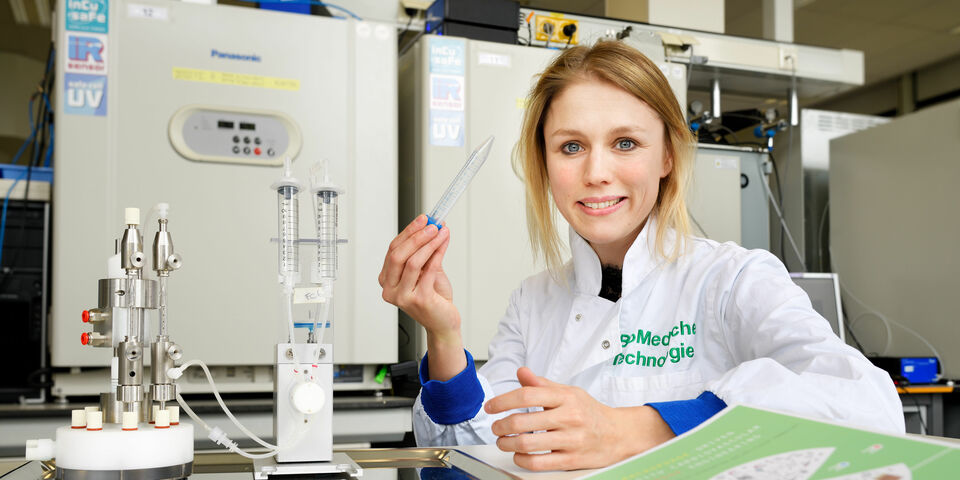Home Stretch | Implant success depends on immune cell
A new blood vessel or a new heart valve? In the quest for the ultimate implant, all eyes have been focused for some time on biodegradable carriers on which the body’s own tissue can grow. BMT doctoral candidate Tamar Wissing saw that certain immune cells are all-important to the success of such implants. In order to study them in detail and to be able in future to steer cell behavior, she built a scaled-down blood vessel.
However well we try to artificially recreate tissues, the best builder is still the body. In view of this, the use of biodegradable plastics is an increasingly popular research topic. These materials prompt the body to make its own new tissue while over time the implant disappears. In this process an all-important role is played by the immune system and during her doctoral research BMT researcher Tamar Wissing discovered that the macrophage - the ‘garbage collector’ among white blood cells - is a key player.
In a healthy body these macrophages are idle. But if they are activated by certain signals, they can recognize and destroy pathogens, dead cells and substances alien to the body. They even clear away the biodegradable implants. But, however, they can also make proteins that set other cells to work making new tissue.
Mechanical load
An impressive piece of multitasking, laughs Wissing. “The balance between breaking down and building is delicate. In our implants macrophages are exposed ceaselessly to environmental factors: other cells, the construction of the implant, as well as the mechanical environment. The bloodstream exerts forces on the macrophages and the shear stress they are subjected to deforms them. They are also stretched by the force of the blood pressure, all of which means a cell is pulled about in a variety of ways. What effect does this mechanical load have on the balance between breaking down and building?”
Bioreactor
It is of course important to understand how cells communicate with each other, Wissing is keen to emphasize. But instead of putting two cells together in a dish, she worked with colleague Eline van Haaften to reconstruct an entire blood vessel in which she could study the behavior of the macrophage.
“Our ability to imitate the human body is ever increasing, thus enabling us to see what really happens in a living being. What's nice about our bioreactor is that we can produce the combination of cellular and mechanical factors. Thus we can see that the microstructure - for example, how the plastic fibers in an implant fit together - has a huge influence on the degradation process.
Uniquely, while we can study the system as a whole, we can also detach factors and look very fundamentally at what an individual mechanical force does to a macrophage. In this way, we have seen that stretching prompts the cell to work like crazy to form tissue, while shear stress, conversely, calms activity and remodels the tissue. So balance is very important.”
Towards clinical use
According to Wissing, the bioreactor is an essential step in the translation from petri dish to human body and should help get bio-implants adopted in clinical use that much more efficiently. Making it possible to compare things in a controlled way, get answers and, in time, steer processes.
Wissing says, “As carriers we are using supramolecular materials from SyMO-Chem, developed in the lab run by Bert Meijer and Patricia Dankers. On these we can hang, for example, certain substances that can influence the macrophages so that the material is degraded less slowly or, conversely, so that tissue is produced more quickly. Hopefully, this will enable us to adapt the implant in ways that are favorable during and after implantation, and we are moving towards the successful implantation of biodegradable tissues.”
For now, Wissing is happy to carry on building. Having built a mini-blood vessel full of macrophages, she is going to turn her attention to calcified veins, for which a new model is also needed. She will be working on this in cooperation with Erasmus University Rotterdam. And in her spare time - she spends three hours a day traveling by train - she is busy making the final improvements to her new home. The macrophage isn't alone in being a multitasker.


Discussion